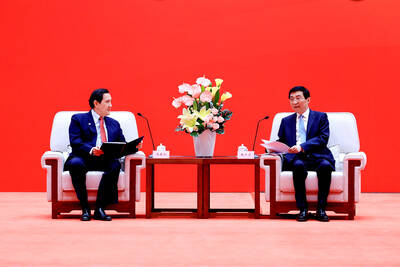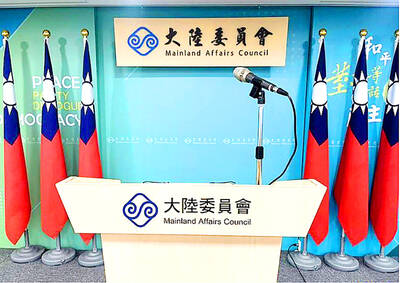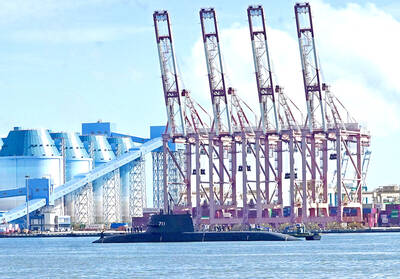Allowing the Straits Exchange Foundation (SEF) and China’s Association for Relations Across the Taiwan Straits (ARATS) to set up offices in Beijing and Taipei could legalize any ongoing under-the-table unification efforts by China and force Taiwan to follow Hong Kong as a Chinese special administrative region, former Mainland Affairs Council (MAC) deputy chairman David Huang (黃偉峰) said yesterday.
Huang, an associate research fellow at the Institute of European and American Studies at Academia Sinica who has served as Taiwan’s deputy representative to the US, made the remark following President Ma Ying-jeou’s (馬英九) proposal on Friday to amend the Act Governing Relations Between the People of the Taiwan Area and the Mainland Area (台灣地區與大陸地區人民關係條例) to allow both the SEF and ARATS to establish branch offices in each other’s capitals.
“Granting ARATS the right to establish an office in Taiwan could have a profound impact on cross-strait relations, as it would most likely follow in the steps of the Liaison Office of the Central People’s Government in Hong Kong,” Huang said on the sidelines of a forum organized by the Taiwan Brain Trust think tank in Taipei.
During the period Hong Kong was under British rule, the Chinese liaison office was known as the Xinhua News Agency Hong Kong Branch — a Chinese institute in charge of everyday Hong Kong affairs, management of Hong Kong-based Chinese-funded companies and even Taiwan-related affairs.
During that time, the agency was considered a bastion of pro-Beijing power, which promoted the rise of Chinese-funded corporations in Hong Kong and also took charge of bilateral talks between Beijing and London over the transfer of Hong Kong’s sovereignty in 1997.
Academics who studied the years before Hong Kong’s retrocession have also pointed out that the Xinhua bureau served as a base from which the Chinese intelligence apparatus collected information within the former British colony.
“If the ARATS is to establish a branch office in Taiwan, it would no doubt become China’s primary base in handling Taiwan affairs and could legitimize all under-the-table work — such as collecting intelligence, influencing public opinion and the media, as well as extending the influence of Chinese-funded companies in Taiwan,” Huang said.
Huang also cautioned that if the SEF were to erect branch offices in the Chinese cities of Guangzhou and Shanghai, they would most likely be defined as semi-official organizations or even as “semi-consulates.”
“Furthermore, if the government is to implement an absentee voting mechanism in the future, Taiwanese businesspeople based in China may have to register with these institutes before they can cast a vote, which could be a decisive factor in future presidential elections and have an adverse impact on opposition parties in Taiwan,” Huang said.
Translated by Stacy Hsu, staff writer

CHIP WAR: The new restrictions are expected to cut off China’s access to Taiwan’s technologies, materials and equipment essential to building AI semiconductors Taiwan has blacklisted Huawei Technologies Co (華為) and Semiconductor Manufacturing International Corp (SMIC, 中芯), dealing another major blow to the two companies spearheading China’s efforts to develop cutting-edge artificial intelligence (AI) chip technologies. The Ministry of Economic Affairs’ International Trade Administration has included Huawei, SMIC and several of their subsidiaries in an update of its so-called strategic high-tech commodities entity list, the latest version on its Web site showed on Saturday. It did not publicly announce the change. Other entities on the list include organizations such as the Taliban and al-Qaeda, as well as companies in China, Iran and elsewhere. Local companies need

CRITICISM: It is generally accepted that the Straits Forum is a CCP ‘united front’ platform, and anyone attending should maintain Taiwan’s dignity, the council said The Mainland Affairs Council (MAC) yesterday said it deeply regrets that former president Ma Ying-jeou (馬英九) echoed the Chinese Communist Party’s (CCP) “one China” principle and “united front” tactics by telling the Straits Forum that Taiwanese yearn for both sides of the Taiwan Strait to move toward “peace” and “integration.” The 17th annual Straits Forum yesterday opened in Xiamen, China, and while the Chinese Nationalist Party’s (KMT) local government heads were absent for the first time in 17 years, Ma attended the forum as “former KMT chairperson” and met with Chinese People’s Political Consultative Conference Chairman Wang Huning (王滬寧). Wang

CROSS-STRAIT: The MAC said it barred the Chinese officials from attending an event, because they failed to provide guarantees that Taiwan would be treated with respect The Mainland Affairs Council (MAC) on Friday night defended its decision to bar Chinese officials and tourism representatives from attending a tourism event in Taipei next month, citing the unsafe conditions for Taiwanese in China. The Taipei International Summer Travel Expo, organized by the Taiwan Tourism Exchange Association, is to run from July 18 to 21. China’s Taiwan Affairs Office spokeswoman Zhu Fenglian (朱鳳蓮) on Friday said that representatives from China’s travel industry were excluded from the expo. The Democratic Progressive Party government is obstructing cross-strait tourism exchange in a vain attempt to ignore the mainstream support for peaceful development

DEFENSE: The US would assist Taiwan in developing a new command and control system, and it would be based on the US-made Link-22, a senior official said The Ministry of National Defense is to propose a special budget to replace the military’s currently fielded command and control system, bolster defensive resilience and acquire more attack drones, a senior defense official said yesterday. The budget would be presented to the legislature in August, the source said on condition of anonymity. Taiwan’s decade-old Syun An (迅安, “Swift Security”) command and control system is a derivative of Lockheed Martin’s Link-16 developed under Washington’s auspices, they said. The Syun An system is difficult to operate, increasingly obsolete and has unresolved problems related to integrating disparate tactical data across the three branches of the military,